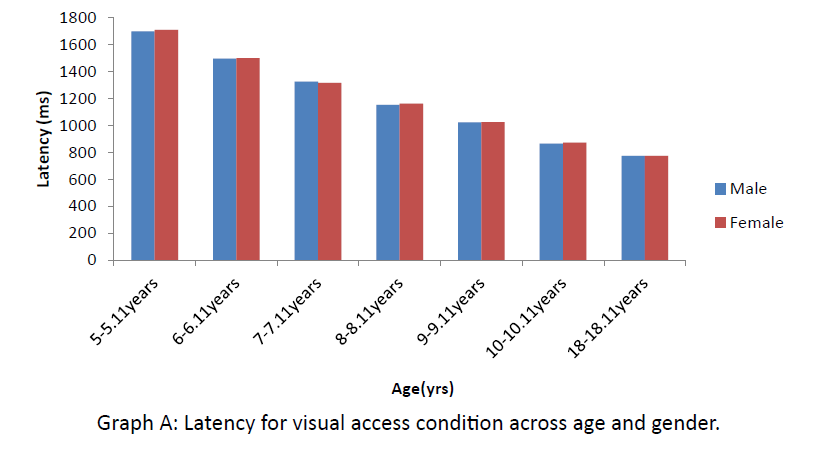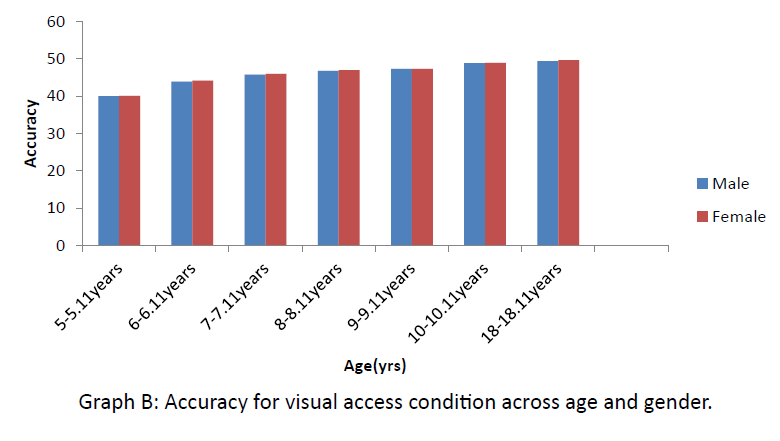Research Article - Otolaryngology Online Journal (2016) Volume 6, Issue 2
A Study of the Development of Lexical Processing In Children- Ministry of Health-sur Hospital, Sultanate of Oman
- Corresponding Author:
- Segana Hasan Abdul Cader
Fellowship European Board ORL- HNS, Department of ENT, Sur Hospital
South ministry of health, Sharqiya region, Sultanate of Oman
E-mail: dr_shac@yahoo.com
Received: March 10, 2016; Accepted: March 24, 2016; Published: March 28, 2016
Abstract
The lexical processing involves a complex array of mechanisms namely, encoding, search and retrieval, whereas, mental representation is the stored information about a lexicon. The levels of lexical processing is observerd is different from children and adults (Tulving, 1972 and Petrey, 1977).The aim of the study was to understand the development of lexical processing in arabic speaking normal children in the age range of 5 to 10 years. Measurement of Latency and accuracy of different lexical access condition tasks were studied and results showed that, Accuracy and latency performance depend on age and they found to be inversely related. The development of lexical processing is a smooth progression from episodic level to young children to semantic level in older children and adults.
Keywords
Lexical processing, Semantics, Visual access conditioning
Introduction
Language has been defined by American Speech- Language-Hearing Association (Committee on Language, 1983) [1-8] as a complex and dynamic system of conventional symbols that is used in various modes for thought and communication, the ability to learn a language is innate. According to the innate universal grammar propounded by Chomsky (1965) phonology and grammatical aspects of language are innately coded and common to all languages whereas semantics and pragmatics are learnt. According to Bowen (1978),”semantics is concerned with the relationship of language form to our perceptions of objects, events and relationships or to cognition and thought”. The semantic aspects of language learning are studied quantitatively by studying the development of size and variety of vocabulary and qualitatively by the study of the aspects involved in naming of referents and concepts. The development of lexicon is sub served by the underlying memory and cognitive processes which form connections between words, referents and their properties. New words are introduced in the lexicon by associating them to concepts by the principle of mutual exclusivity (Markmen et al, 2003).The relationship between the development of word meaning and development of memory has been explained based on the concept of "mental lexicon". It explains the memory process involved in the recognition of a word. A lexicon has been defined as mental encyclopedia, which includes not just a word, but all general and specific information’s, both linguistic and non-linguistic aspects of that word. It has been postulated that there are two aspects underlying the recognition of a word. One is, the stored mental representation, and the other is, the retrieval system, known as lexical processing, which is also termed as lexical accessing.
The lexical processing involves a complex array of mecha nisms namely, encoding, search and retrieval, whereas, mental representation is the stored information about a lexicon [1,2] (Granham, 1985 and Emmorey and Fromkin, 1988).The mental lexicon includes information about pronunciation, linkages between words and words, words and concepts and, concepts and concepts (McCormick and Schiefelbush, 1984).The nature of mental representation in the mental lexicon is speculated from analyzing the levels of lexical processing. The qualitative developmental change in word meaning has been studied in both pre-schoolers and school going Children using various kinds of lexical paradigms such as, confrontation naming of pictures, word association, word definition, openended question, word recall, semantic description, giving members belonging to a category and rhyming task. Most authors (Caroll, 2004; Johnson et al, 1996) agree that the basic steps involved in lexical acces begin at the conceptual level where the concept is selected from a variety of choices in the mental lexicon and through a sequential process end in the verbal production of the word associated with the concept. The levels of lexical processing is observerd is different from children and adults (Tulving, 1972 and Petrey, 1977) (Graphs A and B).
Aim of the study: The aimof the study is to understand the development of lexical processing in in Arabic speaking normal children in the age range of 5 to 10 years.
Hypothesis: The study was carried out to verify the following hypothesis.
1) There is no significant difference in latency and accuracy of lexical processing between children across age groups and adults.
a) For visual access condition.
b) For category naming to single word presented.
c) For category naming to set of words.
2) There is no significant difference in latency and accuracy between genders within each age group.
Methodology of the study: Stimulus materials: The test material consists of fifty items belonging to ten semantic categories i.e. animals, fruits, vegetables, birds, clothing, vehicles, parts of the body, furniture, kitchen items, and teaching aids.
Instrumentation: A Laptop running on windows 7 operating system with DmDx software was used in the study to record the participant responses.
Subjects: A total of 140 subjects were considered for the study in Department of ENT, Head and Neck surgery and audiology/speech therapy in Ministry of Health Sur Hospital, Sultanate of Oman. The subjects were divided into two groups. Group one (experimental group) consisted of 120 children in the age range of 5-10 years. They were further divided into six groups: 5-5.11, 6-6.11, 7-7.11, 8-8.11, 9-9.11, 10-10.11 years. Each group had 10 males and 10 females. Group two (control group) consisted of 20 subjects in the age range 18-18.11 years. Each age group consisted of 20 subjects (M=10, F=10).
Tasks and activities: The study consisted of one main tasks and two supplementary tasks main task: Visual access condition (Task T1) The visual access condition (T1) involved presentation of black and white line drawing pictures of five different nouns from ten categories.
Supplementary tasks: Category naming to set of words presented (ST1) In this task, the five items belonging to a semantic category was presented. Category naming to a single word presented (ST2). In this task, fifty items was presented one by one. Measurement of performance the performance of subjects was measured on two parameters, namely latency and accuracy.
Results and discussion
The purpose of the study was to investigate the development of lexical processing in children.
Task 1: Visual access condition
Latency: Descriptive statistics were obtained for the latency of visual access condition for children and adults and results shows that mean scores for latency were highest for children in the age group of 5-5.11 years for both males and females and lowest latency were obtained for children in the age group of 10-10.11 years for both males and females. The result indicates the latency period decreases as the age increases and variability also decreases with age. Results indicated that the latency difference was significant across all the age group and adult group had shortest latency 774.61 ms followed by children. It was also found that the latency was decreasing as the age advanced.
Accuracy: From the results it is evident that mean scores for accuracy were highest for children in the age group of 10-10.11 years for both males and females and lowest score were obtained for children in the age group of 5-5.11 years for both males and females. Similar to latency, accuracy has shown decreased variability with age and the accuracy has increased with age in the subjects studied. Veena (1984) had compared the comprehension of children in the age range of 5 to 7 and 8 to 9 years and had reported “significantly better performance by older group compared to younger group”. Kamphus and Lozano (1984) have noted that in 6 to 11 year old children the “performance on different language tasks increased with age”.
Task (ST1): category naming of set of words
Results indicated that the latency difference was significant across all the age groups and adult group had shortest latency 874.06 ms, followed by children. It was also found that the latency decreased as the age advanced. Similar to latency, accuracy has shown decrease in variability with age and the accuracy has increased with age in the subjects studied. This increase in performance in accuracy can be the same reason reported by Dempster (1993) which states that with advancing age children increasingly are able to better inhibit irrelevancy.
Task (ST2): category naming to single word
It was also found that the latency was decreased as the age increased. However, no significant difference was noticed in latency of category naming to single words condition across gender. Thus, the hypothesis stating that there is no significant difference between children and adult for latency of category naming to single word task has been rejected. Nelson (1978) has speculated based on the action/function type of response to both basic level term and category term that, the functional aspect forms the basis for the formation of semantic categories.
Summary and conclusion
From the analysis of the data the following conclusions are drawn.
1. Accuracy and latency performance depend on age and they found to be inversely related. This means, as the age advances, more words are retrieved with greater speed.
2. The development of lexical processing is a smooth progression from episodic level to young children to semantic level in older children and adults.
References
- Forster KI (1976) Accessing mental lexicon. In RJ Wholes and ECT Walker (Eds). New approaches to language mechanism Aumterdom: North Holland.
- Allport DA and Funnell E (1981) Components of mental lexicon. Philosophicaltransactions of the royal society, London B 295: 183-196.
- American-Speech-Language-Hearing Association Committee on Language, June, (1983). A definition of language, ASHA 24: 44.
- Bowerman M (1978)the acquisition of word meaning. An investigation into some current conflicts. In Waterron N and Snow C (Eds): The development of communication, New York: John Wiley and Sons 263-287.
- Brown GDA and Watson FL (1987) first in, first out: Word learning age and spoken word frequency as predictors of word familiarity and word naming latency. Memory and Cognition,
- Carroll JB and White MN (1973) Word frequency and age of acquisition as determiners of picture-naming latency. Quarterly Journal of Experimental Psychology 25: 85-95.
- McCormick L and Schiefelburch R (1984) an introduction to language intervention.In early language intervention,McCormick and Schiefelburch (Ed).Charles E. Merrill Publishing Company.A bell and Howell Company: Columbus.
- Nelson K (1978) Semantic development and the development of semantic memory. In Nelson K (Edn) children's language Vol-I, New York: Gardner Press, Inc.

